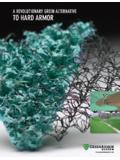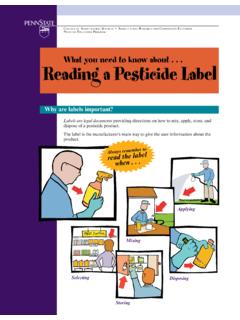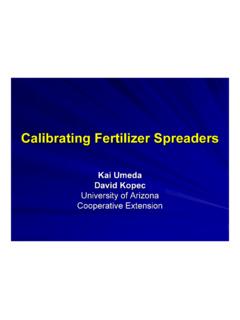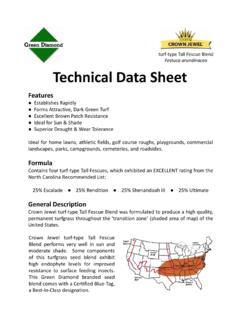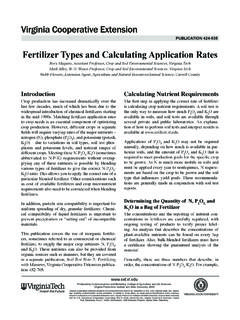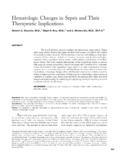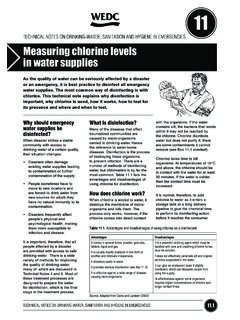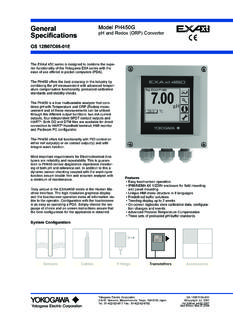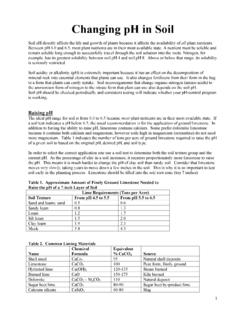Transcription of Soil pH Explained - Green Resource
1 soil pH Explained by Mark Halcomb, UT Area Nursery Specialist, McMinnville, Tenn. and Dr. Donna Fare, Research Horticulturist, National Arboretum, McMinnville, Tenn. Originally compiled by Dr. Willard T. Witte1 This information will relate to plants being grown in a nursery field or landscape. Nutrient availability behaves slightly differently in container media (substrate). All nutrients including the minor elements must be supplied to container grown plants in soilless media. Tennessee soils naturally contain most of the minor elements required for most crops. Introduction soil pH is a measure of the alkalinity or acidity of the soil . soil pH is measured on a logarithmic scale from 0 (strongest acid) to 14 (strongest alkali or base).
2 Neutral is 7. Slightly acid is considered to be to , moderately acid to , strongly acid to , very strongly acid to , and extremely acid below A change of one unit on this scale actually represents a tenfold change in pH. For example a soil pH reading of is 10 times more acidic than a soil with a pH of A soil with a pH of is 100 times more acidic than a soil with a pH of Most Tennessee nursery soils range between and with occasional higher values. If a soil s pH becomes too acidic or too alkaline various key nutrients can become insoluble and unavailable to the plants. Too much lime can be applied. Plants need a proper balance of macro and micronutrients in the soil and the soil pH has an important influence on the availability of nutrients and on the growth of different kinds of plants.
3 For example, when the soil pH is low; nitrogen, phosphorus and potassium are tied up in the soil and not available to plants. Calcium and magnesium, which are essential plant nutrients, may be absent or deficient in low pH soils. 1 UT Extension Nursery Specialist now retired. 1 2 Low pH increases the toxicity of aluminum, iron and manganese; however, in soils with proper pH, they are non-toxic and elements like sulfur, calcium, magnesium, and molybdate will be available for plant uptake. The decomposition of organic matter improves soil structure. If soil pH is low, then the activity of soil organisms that break down organic matter is reduced. Proper soil pH increases microorganism activity which produces improved soil tilth, aeration and drainage.
4 This is turn allows for better use of nutrients, increased root development, and drought tolerance. Soils Tend to be Acid Tennessee soils naturally tend to become acid in reaction with pH values from to Newly cleared land will generally test in the Warren County area of Middle Tennessee. This is due to the removal of base forming ions (Ca, Mg, K) and subsequent replacement by acid forming ions (H, Al). The following conditions enhance or speed up this acidifying process. 1. Application of acid forming fertilizers which produce large amounts of H ions, such as urea, ammonium and sulfate fertilizers. 2. Removal of base forming ions by crops. 3. Removal of base forming ions by leaching and erosion. 4. Decomposition of organic matter which produces carbonic acids.
5 5. Tennessee soils gain approximately 16-18 pounds Sulfur per acre per year from auto emissions and coal smoke that settles here from various states. This gain is expected to diminish with more restrictions. While sulfur will lower the pH, it is one of the minor elements required for plant growth and is a benefit. 6. Rain and snow contribute 10 to 15 lbs per acre of Nitrogen (N) and probably 10 to 20 lbs per acre of Sulfur (S) annually. The S is highly variable depending on wind patterns from industrial emission sources. There is as much N in rain as there is in snow actually. Historically there has been enough S in rain and snow to cover our crop needs. That may be doubtful now with improved pollution control and very high yields like 200 bushel per acre corn, but I suspect it is still true for nursery By adding base forming ions (that is, the Ca and Mg in lime and dolomite) the acid forming ions are displaced and the soil pH rises.
6 Lime recommendations are made based on soil test results and the past experience that the University of Tennessee has with our soils. 2 B Dr. Paul Denton, UT Extension soil Scientist, 9-07 3 soil Chemistry Affected The chemical availability of nutrients may be affected by pH as follows: 1. Manganese availability increases as pH drops with toxic symptoms occurring on some plants at pH or below. In some soils in Tennessee this is an important factor, as manganese is concentrated heavily enough to exist as pellets . These look like shot gun pellets on the soil surface after a rain. 2. The availability of phosphorus, one of the major plant nutrients, decreases as pH rises or falls from about 3.
7 The availability of copper and zinc is greatest between and 4. Calcium, magnesium, and molybdenum become less and less available as pH drops from to 5. The activity of soil microorganisms affecting organic matter decomposition and nutrient availability (especially nitrogen) may be greatly reduced as soils become more and more acid. In summary, these are all good reasons for keeping the soil pH between and for most plants, but there are some exceptions. Preferred pH Ranges Every kind of plant is believed to have a preferred pH range for its best and fastest growth. A few kinds of plants grow best in a rather narrow pH range, while most plants fortunately tolerate a wide pH range. Rarely does any one kind of plant grow equally well in both distinctly acid and distinctly alkaline soils.
8 We are all familiar with the gardener s rough classification of plants into acid loving and lime loving and there is quite a bit of truth in this grouping provided we don t carry it too far. Acid loving generally refers to plants that do well between pH and with a preferred range of perhaps to This group contains all the ericaceous plants: heath, heather, azalea, rhododendron, mountain laurel (Kalmia), leucothoe, huckleberry, bearberry, pernettya, andromeda, blueberry, etc. The acid loving group also contains some of our choice small native flowering trees such as fringetree, silver bell, sourwood, yellowwood, franklinia, and stewartia which are adapted to the acid organic conditions of the forest floor. Acid loving plants, especially the ericaceous ones, are often said to be lime-intolerant.
9 This is thought to be due to the inability of their roots to take up iron under neutral or alkaline conditions, even though iron may be present in the soil . Most of us have seen the visual symptoms of iron chlorosis of azaleas grown in alkaline soil the new leaves yellow except for the veins, or in severe cases all the new growth on one or more branches may turn completely yellow. Another feature of ericaceous plants is thought to be a tolerance of the large amount of aluminum ions present in strongly acid soils. 4 On the other side of the pH scale are the lime lovers, typified by plants that thrive or at least tolerate alkaline conditions and just won t do as well in strongly acid soil . Some examples are lilac and mockorange. Some would put elm, quince, linden and some junipers in this group.
10 Many desert plants grow in alkaline soils but it is hard to pin down a pH range for this group, but somewhere around to or higher would seem about right. The main point to be made is that most of these plants grow perfectly well in slightly acid soils but can also tolerate more alkalinity than most other plants. A third group could be broken out for those plants which do best in moderately acid soils of to This includes the majority of nursery crops. What to Do? So what does all this mean to the nursery producer, landscaper, or gardener? Most obvious is that one should not attempt to grow acid loving and lime loving plants side by side one or the other is going to suffer. It would seem to make sense to group the plantings into two or three groups according to preferred pH range of the plants, such as strongly acid - or to ; moderately acid - to ; and slightly acid to alkaline - to Then the soil could be managed to bring the pH near the desired range.
